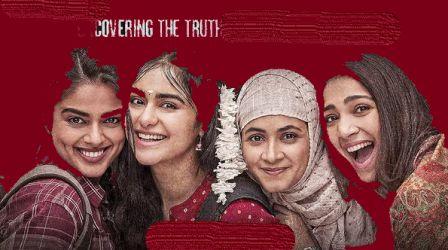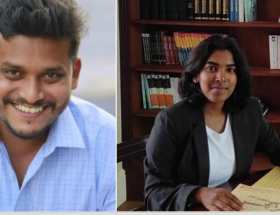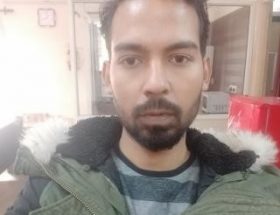Brahmanism and Politics of Production of Muslimophobia – I
Bobby Kunhu
This is the first of a two-part series of examples of the production of Muslimophobia in India and its hegemonic linkages. The second part is here.
“It would not be impossible to prove with sufficient repetition and a psychological understanding of the people concerned that a square is in fact a circle. They are mere words, and words can be molded until they clothe ideas and disguise.”
― Joseph Goebbels
Most cinema in India (across languages) – including so-called arthouse cinema – works on reinforcing all complex shapes that define Indian social polity into circles. In other words, most cinema reinforce existing hegemonic structures. So, caste is entrenched into every small detail of most cinema made in India in almost every aspect, including characterizations, spoken language, character names and often the pecking order of the cinema industry is structured around caste. This is done with a façade of artful sophistication, glamour and technology through an industrial framework that is well funded at $ 4.7 Billion.
The evolution of cinema in India has always mimicked the political zeitgeist. While the earlier days of most Bollywood cinema was based on a Congress idea of India with it subtle version of Gandhian casteism that was cast by ignoring caste in its narrative. Let me explain this seeming contradiction. Many of these movies revolved around the trope of romance, the fructification of which was seen as marriage. Many narratives examined whether romance was successful or a failure depending on its perceived fructification. The obstacles to romance included class, religion, language, ethnicity and even feudalism – but inter-caste romances were largely ignored. The markers of the protagonists and often even main antagonists, including their names signified savarna roots. Dalit-Bahujan characters did have a place in these tableau as lackeys or mise en scène at best. These movies celebrated Muslim narratives as well – savarna Muslim narratives – Mughal-e-Azam, Pakeezah, Nikah, Chaudvin ka Chand are just a few examples. In other words, if one were to use Bollywood as a socio-historical study, one can be forgiven for imagining a secular India, where a few narrow-minded antagonists bickered over religion, ethnicity, language and wealth in a casteless environment.
As a digression, I need to clarify that while Bollywood mimicked Delhi aspirations, regional cinema (at least those that I am familiar with) mimicked the socio political conditions of their respective states. For instance, Tamil cinema was deeply entwined with Dravida politics with at least four chief ministers having been involved in Tamil mainstream movies at different stages of their career. The result being that Tamil cinema came to be dominated by dominant backward castes over a period of time. Malayalam cinema was influenced by communist ideology including groups such as Kerala People’s Arts Club. Of course, while Indian People’s Theatre Association influenced and contributed to the evolution of Bollywood, it has to be borne in mind that its sponsor, the Communist Party of India at that period was in denial of caste as a template of hegemony.
To cut a long story short, Indian film industry, by and large has had a symbiotic relationship with political power, which in turn reflected the social ethos of South Asia. So, it should be of no surprise that when the Hindutva governments across India are busy in the project of rewriting history and renaming places that Bollywood should follow suit. Many actors and directors, who have come out of their casteist and communal closets, and movies without research or quality are being promoted by the state. The Kerala Story is a prime example. Anybody who lives in Kerala (including many right wing bigots – even propagandists) would have no doubt that The Kerala story is a story that has nothing to do with Kerala. The movie is in line with the BJP attempt to demonise Kerala as a communist outlier and crucible for Muslim fundamentalism.
Let me confess, I haven’t watched the movie and I don’t intend to watch it either. But, what qualifies me to write about it is that I have done extensive research on the subject based on which the filmmakers have engaged in Muslimophobic fear mongering. To set the context, Kerala is the only state apart from Kashmir, with a sizeable Muslim population that is crucial in electoral politics. Lacking a popular base and werewithal to make a serious dent in the electoral politics of Kerala, the Hindutva narrative has been to demonize Kerala as a Communist outlier and a crucible for Muslim fundamentalism. (BJP’s enormous financial muscle also hasn’t been of help in Kerala because of its demographic configuration). Prime Minister Modi compared Kerala to Somalia disregarding the global HDI standards of the state.
Love Jihad, the kernel of hate fiction from which The Kerala Story emerged was one of the attempts to establish Kerala as a Muslim fundamentalist hub. It is rooted in the medieval misogynistic worldview of women being chattel to be captured/raped in wars causing dishonour to the enemy ranks, without the ability to discern what is good for them and of course the perceived hyper sexuality of Muslim men. While the term itself was coined in 2009 by a Syrian Catholic Bishop at the Catholic Bishops Council of Kerala in 2009, it gained legitimacy because of the higher judiciary in Kerala and Karnataka, again in 2009.
In Kerala, when the marriage between adult Hindu and Christian women to two Hindu men was subject to an habeas corpus petition before the High Court. A division bench of the High Court treated the case –with empathy – the angst of patriarchal and conservative parents at their adult daughters making choices on their own. The women were persuaded to go with their parents, though they had expressed their unwillingness to do so. An anticipatory bail application went before Justice K. T. Sankaran who invoked love jihad and for the first time gave it a veneer of legitimacy. Justice Sankaran’s order is an interesting rant based on a purported case diary and despite the Division Bench’s direction that the men shouldn’t be arrested till the disposal of the habeas corpus petition and that prima facie no offence was committed by them. Despite the then Director General of Police submitting two affidavits, the second in a sealed envelope based on reports from the Police Chiefs of all the fourteen districts of Kerala, categorically denying the existence of love jihad, the Union Government also submitting an affidavit that love jihad doesn’t exist, Justice Sankaran couldn’t let go of his pet theory. The order reeked of Muslimophobia and even a cursory reading would show that it had no basis in law or facts.
As an important digression, it would be pertinent to point out the purported case diary, unnamed sources and anonymous allegations that shaped Justice Sankaran’s worldview was claimed by a member of the Kerala police, who was openly a member of Hindutva organisations. Justice Sankaran’s misogynistic claim “The case diary would further reveal that several compact discs were given by Shahan Sha to the girls. Most of them were obscene films” – as if women can be seduced to convert into a religion using pornography – was the resonance of the argument that this policeman told me in an interview that he gave me during that period. He also stressed that organisations like Popular Front of India were giving stipend for Muslim men to seduce non-Muslim women.
Meanwhile, in Karnataka, a bench comprising Justices Sreedhar Rao and Ravi Malimath directed a Special Investigation Team investigation in a similar petition despite the woman informing the court that she had converted and married of her free will. But the bench disposed the petition after the SIT found no love jihad angle. It speaks volumes about social prejudices that a concept like love jihad can be entertained by even higher judiciary.
Within a week of Justice Sankaran’s order, to save itself from further embarrassment, the Kerala High Court transferred the case to Justice Nambiar, who found prima facie merit in the petitioner’s prayer and granted stay of prosecution, while ordering District Judges of Thiruvananthapuram and Ernakulam for detailed reports. In December, 2010, it was found that there was no merit in the complaints and the FIRs were quashed. Justice Sankaran’s order kick-started a perverse discourse that was amplified by the local media and had done sufficient damage. The quashing of the FIRs did not receive a fraction of the media frenzy that oversaw the prosecution of the young men.
The result was an atmosphere of fear, particularly for young people (particularly women) who were romantically involved with Muslims. Much after Justice Nambiar’s exoneration, a young Syrian Christian journalist friend, working for one of the prominent news channels was illegally confined to her house because her relatives found that she was friends with a Muslim man. Mutual friends organized an operation that helped her escape her illegal confinement and she was driven non-stop from Kannur to Thiruvananthapuram where she approached the Kerala DGP and explained her situation. In the meantime, her parents had filed a complaint against the man, who was not even involved in this operation and his family was harassed by the police. Timely intervention by the DGP’s office ensured that the local police stepped back, but the woman’s family continued threatening the man’s family. It made matters worse that after both the Kerala Police and the High Court had dismissed the love jihad conspiracy, the then Chief Minister of Kerala raised the bogey at a press conference in Delhi asserting that there was a plan afoot to Islamize Kerala through money and marriage.
Another incident occurred in 2016 reigniting the love jihad discourse in Kerala that was rife with speculation of non-Muslim women being targeted for extremism. Akhila, a Homeopathy student converted to Islam against the wishes of her parents, changing her name to Hadiya. She got into an arranged marriage through an online matrimonial website. Her father, a professed atheist, filed an habeas corpus that speculated on an organized network targeting non-Muslim women to be exported to Syria and his daughter being a “victim” of such a conspiracy. Despite, Hadiya appearing before an adult who appeared before the court emphasising her free will and protesting that she wasn’t planning on any trips abroad, given that she didn’t even have a passport, in a bizarre move, the Kerala High Court assumed parens patriae (guardianship), directed her to be (confined) with her parents and annulled the marriage that she had contracted with Shafin Jahan. Shafin Jahan had to approach the Supreme Court, which restored Hadiya’s freedom and marriage. Despite the fact that Hadiya had converted to Islam and her marriage was an arranged after-event, the media went overboard portraying the same as love jihad.
All this was happening in the backdrop of an attempt at portraying Kerala as a hub for ISIS recruitment and activities without any evidence. Most news reports quoted police officials who remained anonymous, while police officials who voiced their opinion on the issue debunked media exaggerations. On an episode of the show, Talking Point, Chief of Prisons, K. Padmakumar, who was then IG (Intelligence), endorsed my view that Kerala becoming a terror hub was a media exaggeration, much to the disappointment of the host.
All this happening in Kerala was a great propaganda tool for Hindutva juggernaut for selling the idea of a state being invaded by Islamism in Kerala and more importantly in states that are already in the grip of Hindutva. The production of Kerala story needs to be seen in this context. Claims to truth and research was soon debunked by both critics and responsible journalism. Altnews was quick to point out the incongruity of the numbers that the directors claimed to be of the women who were shipped to join ISIS.
The movies (and Hindutva) claims of 32,000 Kerala Hindu and Christian women having converted to Islam and travelled to West Asia are fascinating given that the total number of foreign fighters for ISIS is only 40,000 (Which comprises largely of people from Saudi Arabia, EU and Russia – of which Indians form a minuscule minority). The United States Department of State’s Country Report on Terrorism – India puts the number of Indians in ISIS at 66, while the Indian Home Ministry puts the numbers at 155, of which less than 20-25% are from Kerala.
But, what both critics of the Kerala Story as well as commentators on Love Jihad on all ends of the ideological spectrum seem to have missed is the actual numbers of conversion in Kerala and the reasons for the same. Data crunched from the 2020 Gazette of Kerala show a total of 506 conversions, of which 241 converted to Hinduism, 144 converted to Islam, 199 to Christianity and 2 to Buddhism. Trashing the St. Thomas Christian cacophony over love jihad, most Christian converts were Dalit Christians to Hinduism and out of the 33 people who converted from Christianity to Islam only 9 were Syrian Catholics and only 2 women! On all accounts, conversions seem to indicate a healthy trend in Kerala, interestingly, reflective of the religious demography of the state. Mischievous disinformation regarding mass conversions to Islam attributed to “anonymous” police sources (who, according to Times of India don’t want to be named for obvious reasons – leaving one wondering what is so obvious) which exaggeratedly tabulates alleged conversions at Tharbiyathul Islam Sabha, Kozhikode and Maunathul Islam Sabha, Ponnani, as conversions of Keralites, whereas people from across the country come to these two centres for converting to Islam adds fuel to the fire of bigotry.
It is in the context of this narrative that the Kerala Story was made, promoted and accepted by an audience that was already revelling in the same ideological paradigm. While the Prime Minister of India praised the movie, BJP ruled states and Hindutva forces openly promoted the movie providing tax exemptions and even providing free tickets, despite the fact that a prima facie case of hate speech can be made out against the movie under Sections 153A and 295A of the Indian Penal Code.
But what is more disconcerting being that apart from criticizing The Kerala Story and perceiving it as an insult to Kerala state, no attempts have been made to locate it within the framework of Muslimophobia in which it is embedded, even within Kerala, as love jihad remains a mainstream discourse point. It is also telling that despite claims to progressiveness by sections of the Malayalam Film Industry and romance being a dominant trope in Malayalam cinema, there has been no imagination to use the farce of love jihad cinematically, allowing the Hindutva juggernaut and the likes of Sudipto Sen and Vipul Shah to exploit the farce in an ever polarising society.
“Success is the important thing. Propaganda is not a matter for average minds, but rather a matter for practitioners. It is not supposed to be lovely or theoretically correct. I do not care if I give wonderful, aesthetically elegant speeches, or speak so that women cry. The point of a political speech is to persuade people of what we think right. I speak differently in the provinces than I do in Berlin, and when I speak in Bayreuth, I say different things than I say in the Pharus Hall. That is a matter of practice, not of theory. We do not want to be a movement of a few straw brains, but rather a movement that can conquer the broad masses. Propaganda should be popular, not intellectually pleasing. It is not the task of propaganda to discover intellectual truths.”
― Joseph Goebbels
~~~
Bobby Kunhu is a lawyer, researcher and writer.
Image: artwork by Kuffir.










